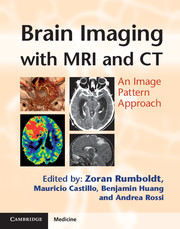Book contents
- Frontmatter
- Contents
- List of contributors
- List of abbreviations
- Preface
- Section 1 Bilateral Predominantly Symmetric Abnormalities
- Section 2 Sellar, Perisellar and Midline Lesions
- Section 3 Parenchymal Defects or Abnormal Volume
- Section 4 Abnormalities Without Significant Mass Effect
- Section 5 Primarily Extra-Axial Focal Space-Occupying Lesions
- Section 6 Primarily Intra-Axial Masses
- 152 Acute Infarction
- 153 Glioblastoma Multiforme
- 154 Therapy-Induced Cerebral Necrosis (Radiation Necrosis)
- 155 Non-Hemorrhagic Metastases
- 156 Cerebral Abscess
- 157 Cerebral Toxoplasmosis
- 158 Primary CNS Lymphoma
- 159 Tumefactive Demyelinating Lesion
- 160 Tuberculoma
- 161 Oligodendroglioma
- 162 Low-Grade Diffuse Astrocytoma
- 163 Gliomatosis Cerebri
- 164 Mitochondrial Myopathy, Encephalopathy, Lactic Acidosis, and Stroke-Like Episodes (MELAS)
- 165 Pleomorphic Xanthoastrocytoma (PXA)
- 166 Ganglioglioma
- 167 Neurocysticercosis – Parenchymal
- 168 Dilated Perivascular Spaces
- 169 Neuroepithelial Cyst
- 170 Subependymal Giant Cell Astrocytoma (SEGA)
- 171 Subependymoma
- 172 Ependymoma
- 173 Pilocytic Astrocytoma
- 174 Medulloblastoma
- 175 Hemangioblastoma
- 176 Lhermitte–Duclos (Cowden Syndrome)
- 177 Hypertensive Hematoma
- 178 Amyloid Hemorrhage – Cerebral Amyloid Angiopathy
- 179 Cortical Contusion
- 180 Hemorrhagic Neoplasms
- 181 Hemorrhagic Venous Thrombosis
- 182 Arteriovenous Malformation
- 183 Cavernous Angioma (Cavernoma)
- Section 7 Intracranial Calcifications
- Index
- References
177 - Hypertensive Hematoma
from Section 6 - Primarily Intra-Axial Masses
Published online by Cambridge University Press: 05 August 2013
- Frontmatter
- Contents
- List of contributors
- List of abbreviations
- Preface
- Section 1 Bilateral Predominantly Symmetric Abnormalities
- Section 2 Sellar, Perisellar and Midline Lesions
- Section 3 Parenchymal Defects or Abnormal Volume
- Section 4 Abnormalities Without Significant Mass Effect
- Section 5 Primarily Extra-Axial Focal Space-Occupying Lesions
- Section 6 Primarily Intra-Axial Masses
- 152 Acute Infarction
- 153 Glioblastoma Multiforme
- 154 Therapy-Induced Cerebral Necrosis (Radiation Necrosis)
- 155 Non-Hemorrhagic Metastases
- 156 Cerebral Abscess
- 157 Cerebral Toxoplasmosis
- 158 Primary CNS Lymphoma
- 159 Tumefactive Demyelinating Lesion
- 160 Tuberculoma
- 161 Oligodendroglioma
- 162 Low-Grade Diffuse Astrocytoma
- 163 Gliomatosis Cerebri
- 164 Mitochondrial Myopathy, Encephalopathy, Lactic Acidosis, and Stroke-Like Episodes (MELAS)
- 165 Pleomorphic Xanthoastrocytoma (PXA)
- 166 Ganglioglioma
- 167 Neurocysticercosis – Parenchymal
- 168 Dilated Perivascular Spaces
- 169 Neuroepithelial Cyst
- 170 Subependymal Giant Cell Astrocytoma (SEGA)
- 171 Subependymoma
- 172 Ependymoma
- 173 Pilocytic Astrocytoma
- 174 Medulloblastoma
- 175 Hemangioblastoma
- 176 Lhermitte–Duclos (Cowden Syndrome)
- 177 Hypertensive Hematoma
- 178 Amyloid Hemorrhage – Cerebral Amyloid Angiopathy
- 179 Cortical Contusion
- 180 Hemorrhagic Neoplasms
- 181 Hemorrhagic Venous Thrombosis
- 182 Arteriovenous Malformation
- 183 Cavernous Angioma (Cavernoma)
- Section 7 Intracranial Calcifications
- Index
- References
Summary
Specific Imaging Findings
The imaging modality in the acute setting is usually CT, which reveals hyperdense mass typically in one of the following locations: basal ganglia, thalamus, central pons, and medial cerebellum. It is primarily the location that allows for hypertensive hematoma characterization on imaging, as blood products have the same appearance irrespective of the etiology. A clot forms after the extravasation of blood, with progressively increasing density over the first 3 days, caused by clot retraction with extrusion of the hypodense serum. This low attenuation surrounding the clot increases in size with development of vasogenic edema. Ring contrast enhancement may be observed around the hematoma. Hypertensive hematomas typically dissect the brain without a considerable amount of associated tissue necrosis, so that chronic lesions are transformed into slit-like hypodense cavities, with a rim of very low T2 signal caused by hemosiderin deposition. MRI is more sensitive than CT for parenchymal hemorrhage, primarily with T2*-weighted images, which frequently demonstrate additional multifocal small hypointensities, corresponding to hemosiderin from previous microhemorrhages. Contrast extravasation on CTA, known as spot sign, predicts hematoma expansion.
Pertinent Clinical Information
Hypertensive bleeds more commonly occur in males, on average at around 55 years of age. Rapid elevation of blood pressure is the main predisposing factor, and drugs such as cocaine and amphetamine are commonly responsible in younger individuals. The presenting symptoms depend on the location: confusion and hemiparesis in basal ganglia and thalamus, cranial nerve deficits and coma in pons, and nausea and vomiting in cerebellum.
Information
- Type
- Chapter
- Information
- Brain Imaging with MRI and CTAn Image Pattern Approach, pp. 365 - 366Publisher: Cambridge University PressPrint publication year: 2012
